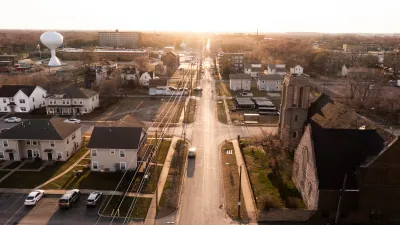A few days ago, I was trying to take a streetcar in Toronto- and the streetcar was just as congested as any suburban arterial. The lines in front of streetcars were so long that I couldn't get into the first streetcar. Or the second. Or the third. Instead, I had to wait a few minutes (horrors!) for the fourth streetcar. I asked myself: what if streetcars only ran every hour, instead of every few minutes? Would the streetcars be equally crowded? Of course not. People would abandon the streetcars and start to use cars (if they owned them) and buy them (if they did not yet own them).
A few days ago, I was trying to take a streetcar in Toronto- and the
streetcar was just as congested as any suburban arterial. The
lines in front of streetcars were so long that I couldn't get into the
first streetcar. Or the second. Or the third.
Instead, I had to wait a few minutes (horrors!) for the fourth
streetcar.
I asked myself: what if streetcars only ran every
hour, instead of every few minutes? Would the streetcars be
equally crowded? Of course not. People would abandon the
streetcars and start to use cars (if they owned them) and buy them (if
they did not yet own them).
In my experience, there is an inverse
correlation between the amount of public transit service and the amount
of overcrowding on trains or buses: in places with extensive
service, overcrowding is a problem- but in places where public transit
is limited to hourly bus service (e.g. Jacksonville, Florida) buses
tend to be delightfully uncrowded, and usually I can not only sit in a
seat but put my bags on the seat next to me. In three years in
Jacksonville, I do not think I ever had to stand on a bus.
This methodology should tell us something
about how and when we build roads. If (as I have suggested) reduced transit service
means less congestion on transit, why should roads be any different?

Manufactured Crisis: Losing the Nation’s Largest Source of Unsubsidized Affordable Housing
Manufactured housing communities have long been an affordable housing option for millions of people living in the U.S., but that affordability is disappearing rapidly. How did we get here?

Americans May Be Stuck — But Why?
Americans are moving a lot less than they once did, and that is a problem. While Yoni Applebaum, in his highly-publicized article Stuck, gets the reasons badly wrong, it's still important to ask: why are we moving so much less than before?

Using Old Oil and Gas Wells for Green Energy Storage
Penn State researchers have found that repurposing abandoned oil and gas wells for geothermal-assisted compressed-air energy storage can boost efficiency, reduce environmental risks, and support clean energy and job transitions.

Updating LA’s Tree Rules Could Bring More Shade to Underserved Neighborhoods
A new USC study finds that relaxing Los Angeles’ outdated tree planting guidelines could significantly expand urban tree canopy and reduce shade disparities in lower-income neighborhoods, though infrastructure investments are also needed.

California's Canal Solar Projects Aim to Conserve Resources and Expand Clean Energy
California’s Project Nexus has begun generating electricity from solar panels installed over irrigation canals, with researchers and state agencies exploring statewide expansion to conserve water and boost clean energy production.

HHS Staff Cuts Gut Energy Assistance Program
The full staff of a federal program that distributes heating and cooling assistance for low-income families was laid off, jeopardizing the program’s operations.
Urban Design for Planners 1: Software Tools
This six-course series explores essential urban design concepts using open source software and equips planners with the tools they need to participate fully in the urban design process.
Planning for Universal Design
Learn the tools for implementing Universal Design in planning regulations.
Heyer Gruel & Associates PA
City of Moreno Valley
Institute for Housing and Urban Development Studies (IHS)
City of Grandview
Harvard GSD Executive Education
Salt Lake City
NYU Wagner Graduate School of Public Service
City of Cambridge, Maryland






























